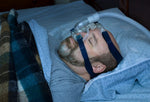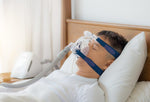On This Page
What Is Sleep Apnea?
Our editorial process includes extensive measures to verify accuracy, provide clarity on complex topics, and present factual information. Read more
Key Takeaways
- Sleep apnea is a sleep disorder in which a person’s breathing repeatedly stops or becomes shallow during sleep.
- Obstructive sleep apnea is the most common type, often identified by loud snoring and fragmented sleep.
- Diagnosis typically involves a sleep study conducted overnight in a sleep lab or at home.
- Treatment options include CPAP therapy, oral appliances, surgery, and lifestyle changes.
Types of Sleep Apnea
There are three types of sleep apnea: obstructive sleep apnea, central sleep apnea, and mixed/complex sleep apnea. The type of sleep apnea is diagnosed based on the cause of a person’s breathing disruptions.
Obstructive Sleep Apnea (OSA)
OSA occurs when a person’s airway becomes partially or completely blocked repeatedly while they sleep, causing their breathing to become abnormally shallow or absent. Airway blockages may be caused by structures in the throat, excess weight in the face or neck, or other changes that constrict the airway. About 10% to 30% of adults in the United States have obstructive sleep apnea.
Central Sleep Apnea (CSA)
CSA is caused by an issue in a part of the brain called the brain stem, which controls a person’s breathing. Problems in the brain stem trigger the sleeper’s respiration to slow or stop for brief periods. Central sleep apnea is less common than OSA, affecting less than 1% of people.
Mixed/Complex Sleep Apnea
Some people experience symptoms of both CSA and OSA, a condition called mixed sleep apnea. Because episodes of mixed sleep apnea typically begin as OSA, this condition is treated like OSA.
Sleep Apnea Symptoms
The symptoms of sleep apnea depend on the type of sleep apnea a person is experiencing. However, some commonly shared symptoms include:
- Excessive daytime sleepiness or napping at inappropriate times
- Disrupted sleep and frequent nighttime waking
- Waking up with a headache
- Difficulties with concentration
Symptoms associated with just obstructive sleep apnea include:
- Snoring loudly
- Waking up gasping or making choking sounds
- Dry mouth in the morning
- Getting out of bed to urinate several times
In general, people with sleep apnea may not notice symptoms until they're pointed out by someone who sees the person sleep. Caregivers or bed partners may notice that a sleeper’s breathing gets slower, faster, or stops while they are asleep.
When to See a Doctor
A doctor can determine if a person’s symptoms are a result of sleep apnea or a different health condition. Several symptoms of sleep apnea, like daytime sleepiness and snoring, can also be caused by other conditions.
Doctors should be notified if new symptoms develop or if current symptoms worsen. Depending on the results of an evaluation, a doctor may suggest undergoing additional testing or working with a sleep specialist.
Causes of Sleep Apnea
Sleep apnea occurs when breathing is repeatedly interrupted during sleep. These pauses in breathing can result from physical blockages in the airway, problems with how the brain controls breathing, or a combination of both. The two main types of sleep apnea (OSA and CSA) have different causes and mechanisms.
Obstructive Sleep Apnea
Obstructive sleep apnea is the most common form of sleep apnea and happens when the muscles in the throat relax too much during sleep. This relaxation allows soft tissues—such as the tongue or the tissue at the back of the throat—to collapse and block the upper airway.
Central Sleep Apnea
Central sleep apnea is less common and occurs when the brain temporarily stops sending proper signals to the muscles that control breathing. In CSA, the airway remains open, but the body simply doesn’t make an effort to breathe for several seconds at a time.
Risk Factors for Sleep Apnea
Research has found several factors that can increase a person’s risk of developing obstructive or central sleep apnea.
Obstructive Sleep Apnea
There are multiple risk factors for obstructive sleep apnea.
- Age: A person’s chances of developing OSA goes up as they get older, reaching its peak in their 60s and 70s.
- Sex: OSA is generally more common in men or people assigned male at birth.
- Body weight: A person’s likelihood of developing OSA increases as they gain weight. Nearly 60% of moderate to severe cases of OSA are related to obesity.
- Anatomical features: Physical differences like an abnormal or small jaw, enlarged tonsils, or the shape of a person’s face may increase their chance of having OSA.
- Health conditions: Health issues related to the heart or kidneys, as well as certain conditions that affect hormone levels, increase the likelihood of developing sleep apnea.
- Substance use: People who use tobacco products and consume alcohol are more at risk of OSA.
Central Sleep Apnea
Central sleep apnea has some of the same risk factors as obstructive sleep apnea, but it is also associated with certain health conditions and other factors.
- Health conditions: CSA can be caused by an infection or injury to the brain stem, a stroke, kidney or heart failure, or an overproduction of growth hormones.
- Age: Symptoms of CSA are more common in people over the age of 65.
- Sex: Men or people assigned male at birth are at a higher risk of CSA.
- Use of certain drugs: Certain medications can increase the risk of CSA, including prescription and illicit opioids as well as some antidepressants.
- Being at high altitude: CSA can also be seen in otherwise healthy people when they spend time at high altitudes.
While men are at greater risk of sleep apnea, part of this difference may be attributed to the underdiagnosis of sleep apnea in women and people assigned female at birth. Differences in symptoms and perceived sleep quality are likely the reason behind this, frequently leading to the misdiagnoses of other conditions that commonly affect women.
Complications of Untreated Sleep Apnea
When left untreated, sleep apnea can have serious effects on both physical and mental health. Repeated breathing interruptions during sleep lower oxygen levels and prevent the body from reaching deep, restorative stages of rest. Over time, this strain can contribute to a wide range of health complications.
- Cardiovascular problems: Untreated sleep apnea has been linked to high blood pressure, heart disease, irregular heart rhythms (arrhythmias), heart attack, and stroke. People with severe sleep apnea are also at higher risk of developing or worsening heart failure.
- Daytime fatigue and impaired focus: Because sleep apnea repeatedly disrupts the sleep cycle, people often experience excessive daytime sleepiness, poor concentration, and memory problems.
- Metabolic and hormonal effects: Sleep apnea can interfere with the body’s ability to regulate glucose and hormones related to appetite and metabolism. Over time, this can lead to insulin resistance, type 2 diabetes, and weight gain.
- Complications during surgery or hospitalization: People with undiagnosed sleep apnea face a higher risk of breathing problems after surgery, especially when sedated or lying on their backs.
Diagnosing Sleep Apnea
Sleep apnea is diagnosed through a combination of clinical evaluation and sleep testing. Because symptoms can overlap with other conditions, doctors rely on a detailed review of your health history, a physical examination, and objective testing
Health History and Symptom Review
In order to diagnose sleep apnea, your doctor will begin by collecting a detailed medical history. During this review, they’ll ask about common sleep apnea symptoms, such as loud snoring, gasping or choking during sleep, morning headaches, and excessive daytime sleepiness. They may also ask whether your partner or family members have noticed pauses in your breathing at night.
Your healthcare provider will also evaluate risk factors that increase the likelihood of sleep apnea, including body weight, neck circumference, family history, alcohol use, smoking, and medication use. They may also ask about coexisting conditions, such as high blood pressure, diabetes, or heart disease.
Sleep Study (Polysomnography)
Although a person’s medical history, symptoms, and the results of an exam can provide information about the likelihood of sleep apnea, a sleep study is needed to confirm the diagnosis.
The preferred type of sleep study for diagnosing sleep apnea is called polysomnography. During polysomnography, a technician places electrodes on various parts of the body to collect information about breathing, heart rate, body movements, sleep stages, and other changes that occur during sleep. The results of polysomnography are used to diagnose the type and severity of sleep apnea, and to develop a plan for treatment.
At-Home Sleep Apnea Testing
Doctors may recommend a home sleep apnea test instead of an in-lab sleep study for people who are highly likely to have obstructive sleep apnea. Testing at home is not an option for people suspected of having central sleep apnea.
Sleep Doctor’s home sleep test offers an easy and accurate way to screen for OSA from home. The test includes an FDA-approved device that measures breathing patterns, oxygen levels, and other key indicators while you sleep. After completing the test, results are reviewed by a board-certified sleep physician, and you'll receive a personalized treatment plan if you're diagnosed with sleep apnea.
Severity Levels of Sleep Apnea
Once a sleep study confirms the presence of sleep apnea, doctors classify the condition as mild, moderate, or severe based on how frequently breathing disruptions occur during sleep. These events are measured using the apnea-hypopnea index (AHI), which represents the average number of apneas (complete pauses in breathing) and hypopneas (partial reductions in airflow) per hour of sleep.
- Mild Sleep Apnea: 5 to 14 breathing interruptions per hour
- Moderate Sleep Apnea: 15 to 29 events per hour
- Severe Sleep Apnea: 30 or more events per hour
Sleep Apnea Treatments
OSA is managed as a chronic health condition and treatments differ based on the severity of the breathing disruptions and a person’s needs. Common treatment options include positive airway pressure (PAP) therapy, oral appliances, lifestyle changes, and, in some cases, surgery to remove or reposition tissue that blocks the airway.
If you completed your sleep test with Sleep Doctor, your Sleep Care Advocate can walk you through all your treatment options and help you get started. From reviewing your results to coordinating equipment delivery and answering setup questions, Sleep Doctor’s care team provides personalized guidance every step of the way to make managing sleep apnea as simple and effective as possible.
CPAP Therapy
Positive airway pressure (PAP) is the most effective treatment for OSA. PAP devices keep a person’s airway open at night by using pressurized air pumped through a medical device and mask. Common types of PAP include:
- Continuous positive airway pressure (CPAP): CPAP delivers a constant, steady stream of pressurized air through a mask to keep the airway open.
- Automatic positive airway pressure (APAP): APAP automatically adjusts air pressure levels during sleep based on changes in breathing patterns.
- Bilevel positive airway pressure (BiPAP): BiPAP delivers two levels of air pressure: higher during inhalation and lower during exhalation.
Oral Appliances
Oral appliances are helpful for some people with OSA. These devices keep the airway open in one of two way:
- Mandibular advancement device (MAD): repositions the lower jaw slightly forward during sleep to help keep the airway open
- Tongue-retaining device (TRD): holds the tongue in a forward position using gentle suction, preventing it from collapsing backward and blocking the airway
A dentist or oral surgeon must select and fit the correct dental appliance for each individual.
Medication
In December 2024, the Food and Drug Administration approved the prescription weight-loss drug Zepbound to treat moderate to severe obstructive sleep apnea in patients with obesity. The medication is the first to be specifically approved for the treatment of OSA.
Surgery
Surgery may be considered when a person does not respond to CPAP therapy or oral appliances, or when the airway obstruction is caused by a structure that can be surgically removed.
- Uvulopalatopharyngoplasty (UPPP): Removes excess tissue from the soft palate, uvula, and throat to widen the airway and reduce obstruction during sleep.
- Hypoglossal Nerve Stimulation (Inspire Therapy): Involves implanting a small device that stimulates the nerve controlling the tongue, helping keep the airway open during sleep.
- Tonsillectomy and Adenoidectomy: Removes enlarged tonsils or adenoids that contribute to airway blockage, most commonly performed in children with sleep apnea.
Lifestyle Changes
In addition to other treatments, doctors typically recommend lifestyle changes that can decrease OSA, such as:
- Maintain a healthy weight: Losing excess weight can reduce fat deposits around the upper airway, helping to decrease airway obstruction and improve breathing during sleep.
- Sleep on your side: Side-sleeping prevents the tongue and soft tissues from collapsing backward into the airway, which is more likely to happen when lying on your back.
- Avoid alcohol and sedatives before bed: These substances relax the throat muscles, making airway blockages more likely during sleep.
-
Quit smoking: Smoking can cause inflammation and fluid retention in the airway, worsening sleep apnea symptoms.
-
Treat nasal congestion: Using saline sprays, allergy medications, or nasal strips can help keep nasal passages open and reduce breathing difficulties.
Treatments for Central Sleep Apnea
For people diagnosed with mild symptoms of CSA, treatment is typically directed at the underlying medical issue that is causing breathing disruptions. For severe CSA or symptoms that don't respond to treatment, a doctor may recommend a PAP device, supplemental oxygen during sleep, or medication.
Explore Your Treatment Options
Frequently Asked Questions
Does snoring mean you have sleep apnea?
Snoring is common, and does not necessarily mean that you have sleep apnea. There are many other causes of snoring, including nasal congestion, pregnancy, and drinking alcohol before bed.
Almost everyone snores on occasion. Snorers who do not have sleep apnea rarely wake up due to snoring or difficulty breathing. People with sleep apnea tend to snore loudly and continuously, and they often wake up choking or gasping for air. Their snoring may be loud enough to be heard through walls and doors.
Is sleep apnea genetic?
Certain risk factors for obstructive sleep apnea are genetic. Compared to those without a family history of OSA, people who have an immediate relative with OSA are two times more likely to develop this condition. Researchers believe that patterns of OSA within families are at least partially linked to shared facial and body structure, as well as a family’s eating habits and patterns of physical activity.
Although there are no known genetic or familial factors involved in central sleep apnea, a genetic condition called congenital central hypoventilation syndrome may raise the risk of CSA.
Can sleep apnea kill you?
Sleep apnea itself doesn’t directly cause death, but when left untreated, it can lead to serious health problems that increase the risk of life-threatening events. Repeated drops in oxygen and frequent awakenings during sleep place significant strain on the heart and cardiovascular system.
Over time, untreated sleep apnea is linked to high blood pressure, heart disease, stroke, and irregular heart rhythms, all of which can be dangerous or even fatal.
Can sleep apnea be cured?
Sleep apnea is typically a chronic condition that cannot be cured. However, there are treatments available that can reduce or resolve symptoms and help people with sleep apnea improve both their sleep and overall health. These include CPAP therapy, oral appliances, medication, and surgery.












